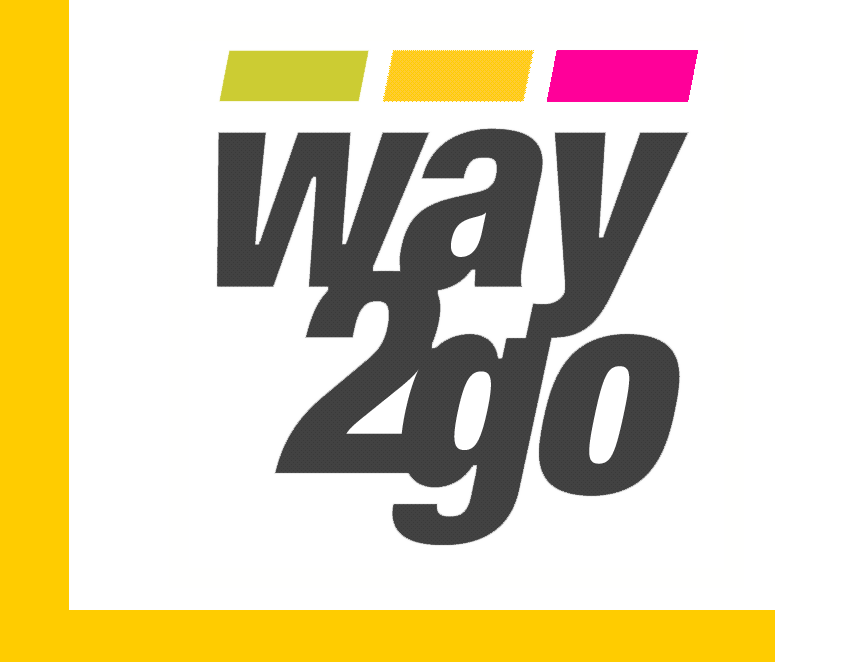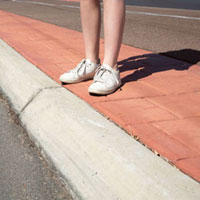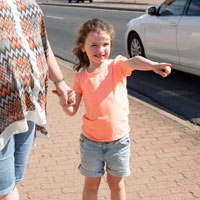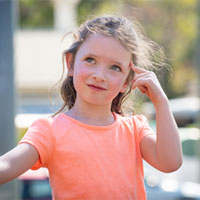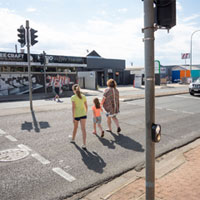Walking
Click the themes below for tips to teach your child to walk safely.
-
STOP, LOOK, LISTEN, THINK, ACT
Use the key questions at each stage to teach your child how to cross the road safely.
Where should you stop?
i.e. kerb, edge of footpath, pedestrian refuge, median strip, yellow line at a railway

Look left, then right, then left again. Listen for traffic as well
What are we looking and listening out for?
What does a car, truck or bike rider, train sound like? (from afar and when getting close)
Why do we look left first, then right and left again?


Walk across the road.
Continue to look and listen for other traffic while you cross the road.
If it is not safe, wait and start Stop, Look, Listen, Think, Act again.
Tip
Make sure that young children hold an adult’s hand to keep them safe. Talk out loud about what you are doing and thinking about as you model Stop, Look, Listen, Think, Act. This helps young children comprehend what you are doing and why.
-
Pedestrian crossings
Learn about the different pedestrian crossings with your child by comparing the features, how they work and where you can find them.
Next time you use a crossing ask your child to describe:
- what type of crossing it is
- how to use it
- why they think a crossing has been installed in that location.
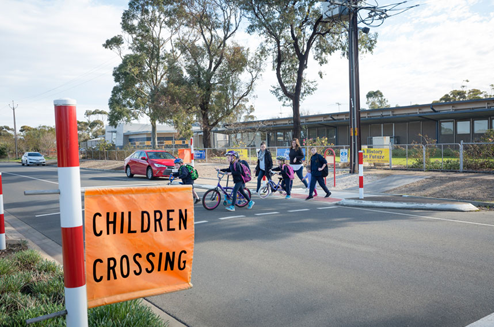
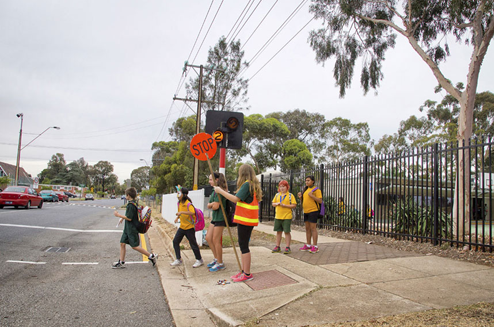
Emu Crossing
Emu Crossings have red and white posts and operate only when the CHILDREN CROSSING flags are displayed.
Emu crossings are placed within School Zones and a speed limit of 25km/h applies 'when children are present'
Koala Crossing
Koala Crossings have red and white posts at the edge of the road and two yellow alternating flashing lights.
As indicated by a sign, a speed limit of 25 km/h applies when the lights are flashing.
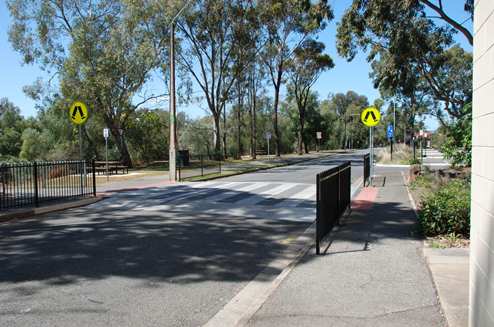
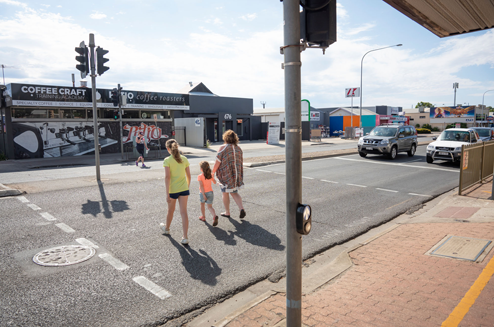
Wombat Crossing
When a pedestrian crossing is placed on a raised section of road they are known as Wombat crossings.
Pedestrian Actuated Crossing
Traffic light signal change is initiated by pressing the button. Pedestrians cross on the green person signal after checking that car drivers have stopped.
Learn about the different pedestrian crossings with your child by comparing the features, how they work and where you can find them.
Next time you use a crossing ask your child to describe:
- what type of crossing it is
- how to use it
- why they think a crossing has been installed in that location.

Emu Crossing
Emu Crossings have red and white posts and operate only when the CHILDREN CROSSING flags are displayed.
Emu crossings are placed within School Zones and a speed limit of 25km/h applies 'when children are present'

Koala Crossing
Koala Crossings have red and white posts at the edge of the road and two yellow alternating flashing lights.
As indicated by a sign, a speed limit of 25 km/h applies when the lights are flashing.

Wombat Crossing
When a pedestrian crossing is placed on a raised section of road they are known as Wombat crossings.

Pedestrian Actuated Crossing
Traffic light signal change is initiated by pressing the button. Pedestrians cross on the green person signal after checking that car drivers have stopped.
-
Useful books about walking
Check out these story books about safe walking.
- Do Princesses Wear Hiking Boots?, by Carmela LaVigna Coyle, Mike Gordon & Carl Gordon ISBN 0-87358-828-2. Publisher – Rising Moon
Why read it? To teach the key message - walking is for everybody. - Henry Hikes to Fitchburg, by D. B. Johnson ISBN -978-0-395-9687-3. Publisher – Houghton Mifflin Company
Why read it? To highlight that walking can be just as fast as and more enjoyable than other forms of transport - I Went Walking, by Sue Williams ISBN – 0-15-200471-8. Publisher – Red Wagon Books / Harcourt, Inc
Why read it? To start a conversation about what you notice during a walk in the local neighbourhood. - Sheep Take A Hike, by Nancy Shaw and Margot Apple ISBN – 0-395-81658-0. Publisher – Sandpiper Houghton Mifflin Books
Why read it? To start a conversation about what they might need to take or pack for a trip (i.e. water, hat) and strategies they could use if they get lost.
- Do Princesses Wear Hiking Boots?, by Carmela LaVigna Coyle, Mike Gordon & Carl Gordon ISBN 0-87358-828-2. Publisher – Rising Moon
-
Useful ideas and links
Victoria Walks - Smart Steps for Families have developed some fantastic activities that families can use to make the walk to and from school lots of fun. To find out more and access these sheets click here.
-
Traffic awareness
Children can learn to be safe and aware of their surroundings in ways that are fun. Try these ideas.
Simon Says (4-7 years old)
What’s that sound?
Signs
I Spy With My Little Eye…
Treasure Hunt (middle to upper primary years)
Teach me
Children can learn to be safe and aware of their surroundings in ways that are fun. Try these ideas.
Simon Says (4-7 years old)
What’s that sound?
Signs
I Spy With My Little Eye…
Treasure Hunt (middle to upper primary years)
Teach me
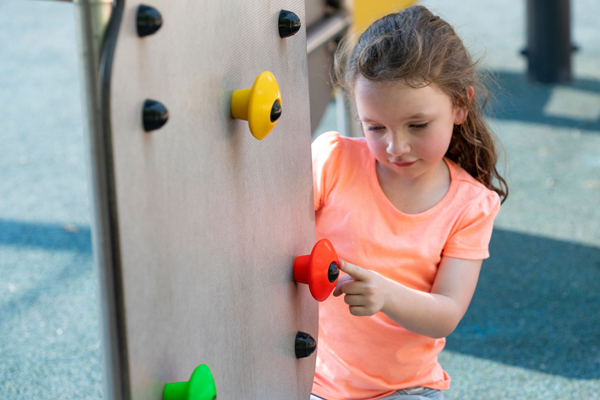 Simon Says (4-7 years old)
Simon Says (4-7 years old)This game will help children understand where you want them to move to or wait when you are travelling. It could also help them to identify traffic light signal colours, see examples below.
Simon says… tap the red climbing peg with your left hand.
Simon says… stand behind the orange slide.
Simon says…hop next to the green climbing peg two times.
Swap roles and make it fun by playing with a group of friends. If you make a mistake sometimes and have them correct it you can tell whether they understand - they’ll find it hilarious catching you out!
What’s that sound?
Western Australia's School Drug Education and Road Aware (SDERA) have developed an online game to help your child learn how to identify traffic sounds and warnings.
Once your child has mastered the sounds ask them to identify the sounds during a journey in your local area. Challenge them to tell you what direction the sound is coming from and if it is close or far away.
Signs
When you go for a trip encourage your child to spot signage along the way.
Ask:-
- What do you think the sign means?
- Why are images used instead of words sometimes?
If you have access to a camera and printer take photos of signage you want your child to understand in your local area. Challenge your child to spot them while you travel and tick them off as you go. Reward their efforts with an experience they’d enjoy.
Older children can take the photos themselves and create a slide show, book or poster for others, e.g. younger siblings, a kindergarten or the school library.
I Spy With My Little Eye…
A classic game that will help your child to be more aware of their surroundings. Use traffic associated language, e.g. stop sign, traffic lights, bike lane.
You could also encourage them to look for patterns outside such as square tiles in the footpath or stripes on a wombat crossing.
Treasure Hunt (middle to upper primary years)
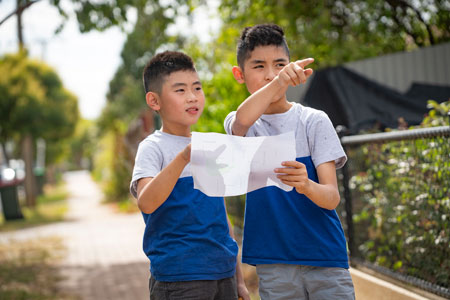 This game works best with a partner. Hide a small treasure at a destination in your local area. Write a list of clues and draw a map to get from the start to the treasure. The clues and map should highlight notable landmarks that help keep them safe and comfortable, e.g. a pedestrian crossing, signage, a park with a water fountain and toilet, significant tree/ building and services such as a library or police station.
This game works best with a partner. Hide a small treasure at a destination in your local area. Write a list of clues and draw a map to get from the start to the treasure. The clues and map should highlight notable landmarks that help keep them safe and comfortable, e.g. a pedestrian crossing, signage, a park with a water fountain and toilet, significant tree/ building and services such as a library or police station.Have the pair use the clues and/or map to find the treasure. They will have fun while they learn to read a map and follow instructions as well as become familiar with their local environment. They will also enjoy problem solving with a friend and learn to work cooperatively with others.
You could also have your child create the map and clues for you to follow. This gives them opportunity to identify key landmarks.
Teach me!
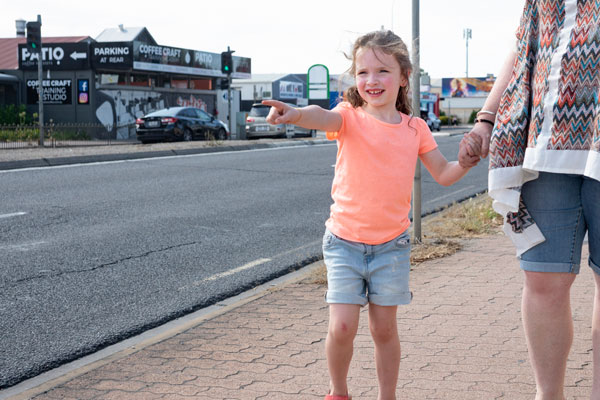 Encourage your child to teach a sibling, friend or grandparents how to safely get from one place to another such as home to the local supermarket. Ask them to talk through what they are doing and why to the person they are teaching. This will help you to assess their level of understanding of steps to keep them safe such as STOP, LOOK, LISTEN, THINK, and ACT. Provide positive feedback on things they are doing right.
Encourage your child to teach a sibling, friend or grandparents how to safely get from one place to another such as home to the local supermarket. Ask them to talk through what they are doing and why to the person they are teaching. This will help you to assess their level of understanding of steps to keep them safe such as STOP, LOOK, LISTEN, THINK, and ACT. Provide positive feedback on things they are doing right.Example
I noticed you did a great job looking out for traffic while we waited to cross the road. You saw there was a car coming and decided to wait rather than run. That was a safe decision, well done!
